Where do bats live?
Bats take up residence near where there is plentiful food, a good water source and protection from predators.
Bats need a clean and accessible water source. They usually swoop down over open bodies of water to take a drink, such as lakes, ponds or streams. Consider building a garden pond with small plants on opposite sides. If you don't have the room for a pond, even a large birdbath in an open area may work.
Bats feed on insects that are active at night, so in order to attract those insects, it may be beneficial to include plants that bloom at night or that have a pronounced nighttime fragrance, such as Evening Primrose, moonflower, datura, four-o’clock primrose, night-blooming water lily, night-blooming Jessamine, cleome, and nicotiana. Add these to your garden, or nearby.
Bats are really picky about where they live....
Michigan has 9 Species of Bats
Big Brown Bat (Eptesicus fuscus)
The big brown bat is the most common bat to be found in Oakland County and surrounding areas. Colonies of females tend to form in the spring and summer and number 20-500 members. Males typically roost alone or together in groups numbering less than 4 or 5. This bat is a colonial bat that prefers hot attics, shutters, bat houses and trees for roosting. During the night, they may roost on porches as they take a break from feeding. During the winter, months, this species is commonly found hibernating in walls and attics. They periodically awaken (every couple weeks), and can accidentally get into the living quarters.
During the summer, the Big Brown Bat usually emerges from its roost about 20 minutes after sunset to forage for insects. The big brown bat has a large puffy nose, is reddish to dark brown in color, and sports a wingspan ranging from 12 1/2 to 13 1/2 inches. Its slow, steady flight, and large size make it fairly easy to identify. Beetles, wasps, mosquitoes and flies from pastures, lawns and vacant lots in the city make up its diet. They are late-dusk fliers that often swoop low to the ground. A colonizing species, big browns roost in buildings and under bridges in summer and hibernate in caves, mines, houses, hollow trees, and even storm sewers in winter. Efficient feeders, the species often roosts for a short nap after gorging itself. Porches, garages, and breezeways are good places to find them. The female gives birth to only one pup per year.
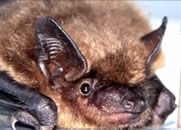
Little Brown Bat (Myotis lucifugus)
The little brown bat is found throughout Michigan, usually observed in the more northern parts of the state. They commonly use echolocation to capture insects that are flying over lakes and ponds. Large colonies consisting of hundreds or even thousands of members commonly take up residence in hot attics or cabins. The little brown bat is especially abundant throughout the state and is the most seen species. A light brown to dark brown in color,they are
fairly small in size with a wingspan of 8 1/2 to 11 1/2 inches, small ears, and large feet. In summer, colonies of the species live in hot attics and under shingles and siding; in winter, they hibernate in caves, crevices, houses, hollow trees, or mines. Females form nursery colonies away from the males. Little brown bats like to feed on aquatic insects and are frequently seen dipping and diving over water but will also forage over lawns and pastures, among trees, and under street lights.
Eastern Red Bat (Lasiurus borealis)
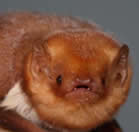 A solitary bat with a 12 inch wingspan. The coat is bright orange to yellowish brown. There is unusual white marking on the shoulders. The females raise between 1-4 young and spend most of their time in trees. Although this species is common in Michigan, it is not one of the bats typically found in homes since it prefers to roost in trees. On occasion, this bat may enter homes through open windows. This bat species is solitary, and should one get in the house, it would not indicate that a colony is present. The red bat also migrates south and is a solitary bat of forests near water. Its long, pointed wings may stretch 12 inches, and it has short, rounded ears, and a furred tail. Color varies from a bright orange to a yellow-brown, and the males are usually brighter in color than the females. Like most other bat species, the red breeds in fall, but conception is delayed until spring when the female gives birth to one to four pups after a
gestation period of 80 to 90 days. Blue jays prey heavily on the offspring. Other predators include opossums, sharp-shinned hawks, great-horned owls, and feral house cats.
A solitary bat with a 12 inch wingspan. The coat is bright orange to yellowish brown. There is unusual white marking on the shoulders. The females raise between 1-4 young and spend most of their time in trees. Although this species is common in Michigan, it is not one of the bats typically found in homes since it prefers to roost in trees. On occasion, this bat may enter homes through open windows. This bat species is solitary, and should one get in the house, it would not indicate that a colony is present. The red bat also migrates south and is a solitary bat of forests near water. Its long, pointed wings may stretch 12 inches, and it has short, rounded ears, and a furred tail. Color varies from a bright orange to a yellow-brown, and the males are usually brighter in color than the females. Like most other bat species, the red breeds in fall, but conception is delayed until spring when the female gives birth to one to four pups after a
gestation period of 80 to 90 days. Blue jays prey heavily on the offspring. Other predators include opossums, sharp-shinned hawks, great-horned owls, and feral house cats. 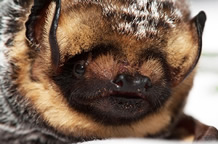
The Hoary Bat (Lasiurus cinereus)
A solitary bat that can be quickly identified by dark hairs tipped with white. The bat also has a yellow to orange throat. This bat spends most of its time in trees and is not commonly found in homes. The hoary bat is Michigan’s largest with a wingspan of up to 15 inches. Heavily furred, the hoary's dark-colored hair is tipped with white giving it a frosted appearance. Its ears are short and rounded. It’s rarely encountered by people and migrates south in winter. It is a solitary species that spends its summer months in forest trees near water throughout Michigan. Researchers know little about their feeding habits and predators.

Silvered Haired Bat (Lasionycteris noctivagans)
A solitary bat sporting a black coat tipped with silver. The wingspan stretches 11 inches. They typically roost behind loose tree bark, but may roost on tall buildings or churches. This bat is uncommon in Michigan. The silver-haired bat lives in forested areas near streams and lakes. Similar in size to the red bat, the silver-haired species is black or dark brown with silver on the tips of its hairs. Considered scarce throughout their statewide range, the silver-haired bat is most easily identified by its slow flight, which is
typically low to the ground. A solitary species, females are thought to establish nursing colonies in June and July when they give birth to two young. A southern migrant, the silver-haired is preyed upon by skunks and great-horned owls.
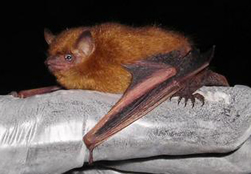 Eastern Pipistrelle Bat (Perimyotis subflavus) or Tri-Colored Bat as it was reclassified in 2008. It does not migrate as it hibernates in caves or abandoned mines through winter in the western Upper Peninsula where it lives year-round. The wingspan can be approximately 9 inches. The bat is one of the smallest species found in the United States. On occasion this bat is mistaken for a large moth. It is rare for this species to colonize in buildings. Like most other bat species, the red breeds in fall, but conception is delayed until spring when the female gives birth to one to four pups after a gestation period of 80 to 90 days. Blue jays prey heavily on the offspring. Other predators include opossums, sharp-shinned hawks, great-horned owls, and feral house cats.
Eastern Pipistrelle Bat (Perimyotis subflavus) or Tri-Colored Bat as it was reclassified in 2008. It does not migrate as it hibernates in caves or abandoned mines through winter in the western Upper Peninsula where it lives year-round. The wingspan can be approximately 9 inches. The bat is one of the smallest species found in the United States. On occasion this bat is mistaken for a large moth. It is rare for this species to colonize in buildings. Like most other bat species, the red breeds in fall, but conception is delayed until spring when the female gives birth to one to four pups after a gestation period of 80 to 90 days. Blue jays prey heavily on the offspring. Other predators include opossums, sharp-shinned hawks, great-horned owls, and feral house cats.
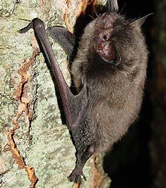
Indiana Bat (Myotis solidalis)
This species of bats numbers less than 300,000 in the world and is an endangered species. The Indiana bat can be identified by its dull brown to grey fur with a pinkish tale membrane. They are similar looking to the big brown bat, however their fur extends beyond their toe nails. They tend to roost in dead or hollow trees in the summer, and form large winter colonies in limestone caves. The Federally endangered Indiana bat is considered rare in southern Michigan, the only region in the state where it resides. A light brown in color, the Indiana bat closely resembles the little brown bat. A southern migrant, the species forms nursing colonies in tree cavities or under loose bark of trees along forested floodplains.
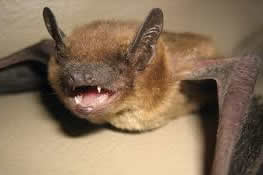
Evening Bat (Nycticeius humeralis)
It can be confused with the big brown or the little brown bat, however the evening bat can be identified by its blunt tragus at the base of the ear. This bat's upper range includes the very southern parts of Michigan. The evening bat lives in extreme southern Michigan and is easily confused with the little brown bat except the evening bat has a curved, rounded fleshy protrusion (tragus) on the ear instead of a pointed tragus. Their wings span 10 to 11 inches. The evening bat flies low to the ground and is sometimes seen swarming around caves,
which it rarely enters. Young are born in summer in colonies that range from a few individuals to several hundred, and litter size is typically two pups
 Northern Long-eared Bats form small colonies, while the males roost alone during the summer. This bat sports a pale to dark brown coat and and have a 10 inch wingspan. The Long-eared bat typically flies in forested areas and will capture insects in flight or on the ground. They prefer to roost in hollow trees or under bark. The northern long-eared bat until recently was also called the Keen's bat, which is now considered a separate species living in Canada. Very large ears make these bats easy to identify at close range. Similar in size to the silver-haired and red bat, the long-eared is brown in color. Although it typically roosts alone in buildings and under tree bark in the summer, small numbers hibernate together in caves, often with big brown bats. The species also forms small nursing colonies of about 30 bats in a tree hollow or under bark.
Northern Long-eared Bats form small colonies, while the males roost alone during the summer. This bat sports a pale to dark brown coat and and have a 10 inch wingspan. The Long-eared bat typically flies in forested areas and will capture insects in flight or on the ground. They prefer to roost in hollow trees or under bark. The northern long-eared bat until recently was also called the Keen's bat, which is now considered a separate species living in Canada. Very large ears make these bats easy to identify at close range. Similar in size to the silver-haired and red bat, the long-eared is brown in color. Although it typically roosts alone in buildings and under tree bark in the summer, small numbers hibernate together in caves, often with big brown bats. The species also forms small nursing colonies of about 30 bats in a tree hollow or under bark.
More often than not, bats get a bad rap. People think of these little creatures as blood-sucking, flying rodents which is tortally undeserved. In fact, these night-flying mammals are gentle, do their best to avoid human contact, and actually have a lower incidence of rabies infection than other wild animals.
So why would you NOT want them lingering around your home? Bats are actually great backyard companions because they are wonderful at controlling unwanted pests.





